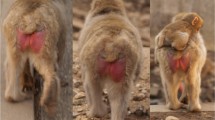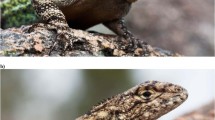Abstract
Several primate species show sexual dichromatism with males displaying conspicuous coloration of the pelage or skin. Studies of scrotal coloration in male vervet monkeys (Chlorocebus aethiops) suggest that it is an important intrasexual signal, with relatively dark, colourful males dominating paler males. To date, no studies have examined the influence of male colour on intersexual social interactions in vervet monkeys. The primary goal of the present study was to evaluate whether female vervet monkeys attend to male coloration. We experimentally introduced females, housed with either “pale” or “dark” males, to stimulus males whose scrota were pale, dark, or pale but painted to look dark. Overall, during introductions, females did not differ in time spent directing affiliative behaviour toward pale, dark, and painted males; however, females, permanently housed with dark males, spent significantly more time directing affiliative behaviour toward pale than painted males. When the stimulus male was pale, affiliative exchanges between males and females were longer than when the stimulus male was painted. Home male colour was not related to female-initiated aggression. Home male colour was also not related to male-initiated aggression, although painted stimulus males were more likely to initiate aggression than pale stimulus males. These findings lead us to conclude that females pay attention to male coloration, but do not bias their interactions toward males solely on the basis of natural male coloration.

Similar content being viewed by others
Notes
The dark males in the present study were comparable in colour measures to the “dark” males in Gerald (2001).
References
Andelman SJ (1987) Evolution of concealed ovulation in vervet monkeys (Cercopithecus aethiops). Amer Nat. doi:10.1086/284675
Andersson M (1994) Sexual selection. Princeton University Press, Princeton
Bercovitch FB (1996) Testicular function and scrotal color in patas monkeys. J Zool (London) 239:93–100
Bowlig N (1978) Communicative signals and social behaviour of some African monkeys: a comparative study. Primates 19:61–99
Burt A (1992) `Concealed ovulation’ and sexual signals in primates. Folia Primatol 58:1–6
Cheney DL (1981) Intergroup encounters among free-ranging vervet monkeys. Folia Primatol 35:124–146
Cooper VJ, Hosey GR (2003) Sexual dichromatism and female preference in Eulemur fulvus subspecies. Int J Primatol. doi:10.1023/B:IJOP.0000005986.21477.ad
Darwin C (1871) Secondary sexual characters of mammals. In: The descent of man and selection in relation to sex. Murray, London
Dixson AF (1997) Evolutionary perspectives on primate mating systems and behavior. Ann NY Acad Sci 807:42–61
Domjan M (2003) The principles of learning and behavior, 5th edn. Wadsworth/Thompson, Belmont
Eley RM, Tarara RP, Worthman CM, Else JG (1989) Reproduction in the vervet monkey (Cercopithecus aethiops): III. The menstrual cycle. Am J Primatol. doi:10.1002/ajp.1350170102
Else JG, Eley RM, Wangula C, Worthman C, Lequin RM (1986) Reproduction in the vervet monkey (Cercopithecus aethiops): II. Annual menstrual patterns and seasonality. Am J Primatol. doi:10.1002/ajp.1350110404
Gartlan JS, Brain CK (1968) Ecology and social variability in Cercopithecus aethiops and C. mitis. In: Jay J (ed) Primates. Holt, Rinehart and Winston, New York, pp 253–292
Gerald MS (2001) Primate colour reveals social status and predicts aggressive outcome. Anim Behav. doi:10.1006/anbe.2000.1648
Gerald MS (2003) How color can guide the primate world. In: Jones CB (ed) Sexual selection and reproductive competition in primates: new perspectives and directions. American Society of Primatologists, Norman, pp 141–172
Gerald MS, Bernstein J, Hinkson R, Fosbury R (2001) A formal method for objective assessment of primate color. Am J Primatol. doi:10.1002/1098-2345(200102)53:2 < 79::AID-AJP3 > 3.0.CO;2-N
Girolami L (1985) Steroid hormone influences on the mating behavior of vervet monkeys (Cercopithecus aethiops). Horm Behav 19:1–13
Hsu Y, Earley RL, Wolf LL (2006) Modulation of aggressive behaviour by fighting experience: mechanisms and contest outcomes. Biol Rev Camb Philos Soc 81(1):33–74
Isbell LA (1995) Seasonal and social correlates of changes in hair, skin, and scrotal condition in vervet monkeys (Cercopithecus aethiops) of Amboseli National Park, Kenya. Am J Primatol 36:61–70
Jacobs GH, Deegan JF (1999) II Uniformity of color vision in Old World monkeys. Proc R Soc B. doi:10.1098/rspb.1999.0881
Johnstone RA, Norris N (1993) Badges of status and the cost of aggression. Behav Ecol Sociobiol 32:127–134
Kappeler PM, van Schaik C (2004) Sexual selection in primates: new and comparative perspectives. Cambridge University Press, New York
Keddy AC (1986) Female mate choice in vervet monkeys (Cercopithecus aethiops sabaeus). Am J Primatol 10:125–134
Kingdon J (1996) The Kingdon field guide to African mammals. Academic, San Diego
Kirk RE (1982) Experimental design: procedures for the behavioral sciences, 2nd edn. Brooks/Cole, Monterey
Pärt T, Qvarnström A (1997) Badge size in collared flycatchers predicts the outcome of male competition over territories. Anim Behav 54:893–899
Spencer KL, Cnaani J, Papaj JR (2005) Peak shift discrimination learning as a mechanism of signal evolution. Evolution. doi:10.1111/j.0014-3820.2005.tb01780.x
ten Cate C, Rowe C (2007) Biases in signal evolution: learning makes a difference. TREE 22:380–387
Mateos C, Carranza J (1996) On the intersexual selection for spurs in the ring-necked pheasant. Behav Ecol 7:362–369
Paul A (2002) Sexual selection and mate choice. Int J Primatol. doi:10.1023/A:1015533100275
Poirier FE (1972) The St. Kitts green monkeys (Cercopithecus aethiops sabaeus): ecology, population dynamics, and selected behavioral traits. Folia Primatol 17:20–55
Pryke SR, Andersson S, Lawes MJ (2001) Sexual selection of multiple handicaps in the red-collared widowbird: female choice of tail length but not carotenoid display. Evolution 55:1452–1463
Radesäter T, Halldórsdóttir H (1993) Two male types of the common earwig: male-male competition and mating success. Ethology 95:89–96
Seier JV, Venter FS, Fincham JE, Taljaard JJ (1991) Hormonal vaginal cytology of vervet monkeys. J Med Primatol 20(1):1–5
Setchell JM (2005) Do female mandrills prefer brightly colored males? Int J Primatol. doi:10.1007/s10764-005-5305-7
Stapley J, Whiting MJ (2006) Ultraviolet signals fighting ability in a lizard. Biol Lett 2(2):169–172
Struhsaker TT (1967) Behavior of vervet monkeys (Cercopithecus aethiops). Univ Calif Publ Zool 82:1–74
van Schaik CP, Hodges JK, Nunn CL (2000) Paternity confusion and the ovarian cycles of female primates. In: van Schaik CH, Janson CP (eds) Infanticide by males and its implications. Cambridge Univ Press, Cambridge, pp 361–387
Waitt C, Little AC, Wolfensohn S, Honess P, Brown AP, Buchanan-Smith HM, Perrett DI (2003) Evidence from rhesus macaques suggests male coloration plays a role in female primate mate choice. Proc R Soc Lond B Biol Sci Supp. doi:10.1098/rsbl.2003.0065
Acknowledgements
We graciously thank Jean Baulu and Genviève Marsh for their support, particularly in welcoming the first author back to conduct this investigation. We are indebted to: Miriam Chon, Stuart Semple and Jodie Jawor for intellectual exchanges; Leemary Davíla for vaginal cytology lessons; Marco Leoni and two anonymous reviewers for comments on an earlier draft; and Tatiana Czeschlik for her patience and helpful advice. We are eternally grateful to Carlisle Sutton for logistical support and brainstorming sessions and to Dr. Mark Phillips, Ricardo Holder, Michelle Morrison, Emerald Thornington, and the Barbados Primate Research Center staff for graciously providing assistance. We extend thanks to Aila Jones, Mahalia Mann, and Wilma Phillips for their patience during the study. Finally, we thank the Caribbean Primate Research Center for granting leave time for MSG from Cayo, Santiago to perform this study. This research adhered to the current laws of Barbados and the Institution of Animal Care and Use Committee for The Barbados Primate Research Center also approved this study and this investigation complied with the “Guidelines for the use of animals in research,” (Animal Behaviour, Vol 43, 1992). Awards to MSG from The Leakey Foundation and an RCMI, University of Puerto Rico Medical Sciences Campus Travel award funded this study. This publication was made possible by Grant Number CM-20-P40RR003640 from the National Center for Research Resources (NCRR), a component of the National Institutes of Health (NIH). Its contents are solely the responsibility of the authors and do not necessarily represent the official views of NCRR or NIH.
Author information
Authors and Affiliations
Corresponding author
Rights and permissions
About this article
Cite this article
Gerald, M.S., Ayala, J., Ruíz-Lambides, A. et al. Do females pay attention to secondary sexual coloration in vervet monkeys (Chlorocebus aethiops)?. Naturwissenschaften 97, 89–96 (2010). https://doi.org/10.1007/s00114-009-0619-5
Received:
Revised:
Accepted:
Published:
Issue Date:
DOI: https://doi.org/10.1007/s00114-009-0619-5




